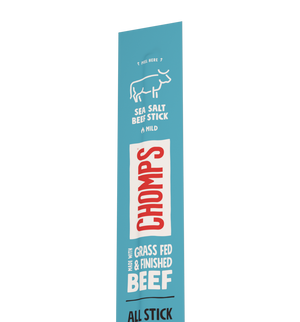
Macronutrients, or macros for short, are a staple in workout and nutrition conversations. We’re exposed to them everyday on labels: this many carbs, that much protein, these types of fats — but what does it all mean? Why should you care?
Nutrition is infamous for being confusing. The science is changing rapidly, and the best answer for how much and of what you should eat, more often than not, is “it depends”.
We’re going to cover what macros are, why they’re important, how to figure out your ideal macro ratios, and cover a few best practices for counting them.
What are macros?
Macros, or macronutrients, are essential nutrients that supply us with energy in the form of calories.
The three main macronutrients are carbohydrates, fats, and protein, and although it’s not described as a macronutrient because it is technically a carbohydrate, we argue that you should treat fiber as an honorary fourth.
In the overview below, we’ll discuss tracking within the context of the core three macronutrients, but remember that fiber is critical, too. Only 5% of adults get their recommended fiber, and it is essential for optimal health[*]. From effective nutrient absorption, to maintaining blood sugar levels, to maintaining a healthy gut microbiome, fiber is often overlooked in modern diets that avoid or reduce carbs[*].
Our bodies need macronutrients in large amounts, which is why we dub them “macro” nutrients. These are different from micronutrients, which are vitamins and minerals that our bodies use in small amounts to perform different processes like build strong bones and help the immune system function[*].
While we all need macronutrients to survive, the amount we need changes depending on our individual bodies and wellness goals. For example, a marathon runner will need more carbohydrates than an office worker who doesn’t get out much.
Macronutrients do have recommended ranges, however, and the The Food and Nutrition Board recommends breaking up your macros as follows[*]:
- Protein: 10 to 35 percent
- Carbohydrates: 45 to 65 percent
- Fat: 20 to 35 percent
- Fiber: 25-30 grams
Macronutrients also have standard amounts of calories. One gram of protein has 4 calories, one gram of carbohydrates has 4 calories, and one gram of fat has 9 calories[*].
Calories vs. Macros
While they are often talked about at the same time, calories are not the same thing as macronutrients. Calories are units of energy, and we need to source calories from food because our bodies need energy to perform the processes it needs to function[*]. Otherwise, you risk shutting down, which is a nice way of saying you’d starve.
The confusion between macros and calories occurs because the amounts of macronutrients we need depend on our daily caloric needs.
For example, if we need 2,000 calories a day and our nutritionist recommends that we eat 50% of that in carbohydrates, then we would need 1,000 calories of carbs, which at 4 calories per gram = 250 grams of carbohydrates per day.
If that was a little bit confusing, don’t worry — we walk through calculating your macronutrient needs in more detail later on.
And remember, when it comes to weight loss, all that matters is calories in, calories out. If you eat fewer calories than you need each day, then you’ll lose weight. If you surpass how many you need, you’ll gain weight — regardless of what you eat. It’s that simple!
Macronutrient #1 - Proteins
Proteins are nutrients made up of building blocks called amino acids, and there are over 10,000 proteins that make up what you are and help you in different ways[*].
Nine of the twenty or so amino acids (histidine, isoleucine, leucine, lysine, methionine, phenylalanine, threonine, tryptophan, and valine) are known as essential amino acids because they come from food[*].
Proteins build and repair tissue structure, regulate metabolism, help regulate the pH of our bodies, and more[*]. They are also critical to building muscle and can help you feel full.
Recommended Intake:
10-35% of your daily caloric intake
Healthy sources of protein:
- Chicken
- Fish
- Beef
- Beans
- Lentils
- Organic or fermented soy
- Eggs
- Yogurt
- Milk and other dairy
Macronutrient #2 - Carbohydrates
Carbohydrates, or carbs, are simply sugar molecules. Your body breaks down these molecules into glucose, which is the main source of energy for your tissues, cells, and organs [*].
Carbohydrates help fuel the body during exercise, preserve muscle mass by taking the workload off of protein, and act as energy for our brain[*]. Nutritionists typically recommend eating 45-65% of your daily caloric intake in carbohydrates[*], although diets like keto or carnivore opt for a low or zero-carb intake[*].
There are three main types of carbohydrates: sugars, starches, and fiber[*]. Sugars are known as simple carbohydrates because they are the most basic form of carbohydrates. Starches and fibers are known as complex carbohydrates because starches are collections of sugars strung together and fiber cannot be broken down into simple sugars by the body.
Recommended Intake:
45-65% of your daily caloric intake.
Healthy sources of carbohydrates include:
- Whole Grains
- Fresh fruits
- Starchy roots and potatoes
- Rice
- Beans
Macronutrient #3 - Fats
Fats, or lipids or fatty acids, are nutrients made up of three molecules strung together. Most of the fat our bodies need we can make ourselves, but there are “essential fats” such as Omega-3 and Omega-6 fats that we have to get from food[*].
If you remember the fish oil craze, essential fats were behind it[*].
Fats act as energy reserves, provide insulation, protect organs from damage, and help transport vitamins[*], and there are three main types of fats we eat[*]:
- Unsaturated fats from plants
- Saturated fats from animals
- Trans fats from processed foods
Unsaturated fats are considered the most healthy, saturated fats are fine in moderation, and trans fats are considered the worst for you.
Recommended Intake:
20-35% of your daily caloric intake
Healthy sources of fats include:
- Oil
- Butter
- Grass-fed beef
- Avocados
- Coconuts
- Fish
- Eggs
- Nuts and seeds
Honorary Macronutrient #4 - Fiber
Fibers are a type of carbohydrate cannot digest, which means it passes through the system undigested [*].
Fiber is a sort of supernutrient since it’s found in so many different foods. Diets high in fiber have been linked to better gastrointestinal health, reduced risk of stroke, lower chances of type 2 diabetes, and even less risk of some cancers[*].
There are two types of fiber: soluble fiber, which means they dissolve in water, and insoluble fiber, which means they don’t.
Soluble fiber can lower glucose levels and blood cholesterol.
Insoluble fiber helps move food through the digestive system, promoting regularity and efficient bowel movements[*].
It’s easy to hit your macros while neglecting fiber, so if you are hitting your macros and workouts but aren’t seeing the body recomposition you want, take a closer look at your fiber intake.
Recommended Intake:
20-30 grams per day
Healthy sources of fats include:
- Beans and other legumes like lentils
- Broccoli
- Seeds
- Berries
- Whole wheat grains and pasta
- Fruits and potatoes with the skin.
How to Figure Out Your Ideal Intake
The ideal macronutrient ratio for you depends on how many calories you need each day and your weight loss and/or fitness goals. If you are just looking to eat a balanced diet and aren’t concerned with developing a more strict or nuanced plan, then simply eating within the macronutrient ranges we listed above across a balanced diet is more than enough.
But, if you are interested in IIFYM or flexible dieting, or simply want to dig a bit deeper into your nutrition, then follow these steps:
Your TDEE is a combination of your basal metabolic rate (BMR) and your activity level, which is just a fancy name for figuring out how many calories your body needs each day to maintain your weight.
The formula for BMR uses your weight, height, age, and other factors like gender to calculate how much your body burns without activity, and then you take that result and multiply it by these levels:
- If you rarely exercise, multiply your BMR by 1.2
- If you exercise on 1 to 3 days per week, multiply your BMR by 1.375
- If you exercise on 3 to 5 days per week, multiply your BMR by 1.55
- If you exercise 6 to 7 days per week, multiply your BMR by 1.725
- If you exercise every day and have a physical job or if you often exercise twice a day, multiply your BMR by 1.9
For an easy BMR and TDEE calculator, go here.
Step 2: Determine your fitness goals
Once you have TDEE, you need to figure out what your fitness goal is.
If your goal is just to lose weight, then you can eat around 300-500 calories less than your TDEE each day, eat the recommended macronutrient amounts, and you’ll be fine!
If you are trying to gain muscle and are going to the gym, then you’ll want to exceed your TDEE and adjust your macronutrient breakdown to something close to this[*]:
- Protein: 0.8–1 grams per pound bodyweight per day (20% or so of calories)
- Carbs: 3+ grams per pound bodyweight per day (50–60% of your calories)
- Fat: the remaining 20–30% of your calories.
So if your TDEE was 2,500, maybe you eat 3,000 calories with this split, which would be around 150 grams of protein, 450 grams of carbs, and 65g of fat. And ideally, 25-30 grams of your carbs intake would be in fibers.
If you are trying to maintain muscle while losing weight, then your splits will be the same percents as above but eating at a TDEE deficit, say 2,000 in our same example.
Remember: everyone’s needs are different.
Ultimately, the best course is to get a rough idea of what you think you need, start tracking, and then adjust accordingly to your own results. Only you can know if your diet works for you, and remember to eat as balanced a diet as possible when tracking your macros and work with a professional when you can.
Step 3: Start tracking!
When you establish your baselines, it’s best to track what you’re eating for a few days to make sure you are being true to your splits. Good tools for this include:
Why People Count Macros
From weight loss to weight gain, to simply evaluating their meals for context, counting macros is popular for many reasons. The most famous example is If It Fits Your Macros, or IIFYM.
IIFYM, also known as flexible dieting, is less of a diet and more of an approach to life. The idea is that after you match your macros to your fitness goals, as long as you hit them, you don’t have to look at any foods as “good” or “bad”.
Advocates of this lifestyle stress the psychological benefits of erasing stigmas from specific foods and prioritizing a healthy diet with guilt-free treats that work together to better your physical and mental health.
Benefits of Counting Macros
May help maintain muscle mass
Because counting your macros puts a greater emphasis on understanding your protein content, it’s likely that as a result of counting your macros alongside a fitness plan that you will maintain, if not increase your muscle mass through more appropriate or increased protein consumption.
Because macros focus on what is inside foods instead of eliminating categories of foods, it allows more room for you to enjoy your food and life. Research shows that balanced, less-intense approaches to dieting tend to have more of an impact on long-term health than short-term, highly-restrictive diets[*].
Because you will be tracking and thinking about the nutrient breakdowns in food more often than you otherwise would, counting macros can improve the health of the choices you make on a daily basis.
Downsides of Counting Macros
As you can tell, it does take a bit of upfront work to establish your baseline. You have to calculate your TDEE, match that to your activity level, and then adjust it according to what you want to accomplish from a dietary perspective. It’s not hard, per se, but it’s not as simple as just cutting out carbs, for example.
Just like calorie counting, there’s a risk to obsessing over macronutrient counts in a way that is psychologically damaging. If you notice yourself becoming obsessive about the macronutrient balances and meticulously tracking everything at the expense of your happiness, consider stepping away from this approach for a bit.
There’s a darker side to IIFYM, which expresses itself in ways like “dirty bulking”. The idea is that because you only have to worry about your macronutrient counts, you can eat whatever you want as long as it fits your macros. That could be fast food, other processed foods, candy — you name it. While this is true from a caloric and macro perspective, it is not a healthy way to live, and evidence for eating a balanced diet dwarfs any other approach.
The Bottom Line
The three main macronutrients are protein, carbohydrates, and fats, and they are nutrients we need to eat in large amounts to help our bodies function optimally. Fiber is also important for general health, and we recommend tracking fiber as an honorary macronutrient. The ideal balance between these macronutrients depends on your weight, gender, TDEE, and fitness goals.
Once you establish your ideal range, tracking macronutrients can be a useful way to shape your diet to get the nutrients and calories you need to maintain, gain, or lose weight and/or muscle mass.

































